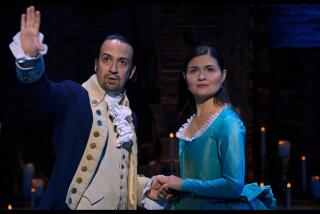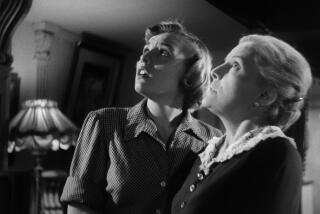A Fair Question for a Centennial
ST. LOUIS — For one glorious summer a century ago, St. Louis had it all.
The Olympics -- the third to be held in the modern era -- brought the world’s best marathoners, high jumpers and tug-of-war warriors to a stadium in the dust-clogged countryside.
The World’s Fair transformed a swampy urban park into a glorious showcase of newfangled inventions: the X-ray machine, the dishwasher, cotton candy, the ice-cream cone, even an incubator for premature babies.
International pavilions carried the world to the heartland: marble sculptures from Italy; silk shoes from China; and scores of loincloth-clad Igorot tribesmen from the Philippines, who were displayed in a mock village like animals at a zoo.
A huge Ferris wheel, 25 stories tall, shimmered above the fairgrounds. Grand boulevards unfurled past beaux-arts palaces. A mile-long carnival arcade featured contortionists, a Boer War reenactment and a sideshow act billed as Jim Key -- the Educated Horse.
Many here still consider that summer of 1904 this city’s grandest moment.
The question dividing St. Louis now is how to commemorate it.
A six-week festival of free concerts to mark the centennial kicked off last weekend under the Gateway Arch with the Neville Brothers and the B-52’s. About 90 miles west, at Onondaga Cave State Park, rangers planned a turn-of-the-century celebration: Kids played hopscotch to a ragtime band, then cooled off with that novel medicinal tonic, Dr Pepper.
The Missouri History Museum has opened an exhibit with 250 artifacts, including an Olympic medal from the tug-of-war contest. A feature-length documentary, “The World’s Greatest Fair,” premiered here last week to sold-out crowds.
But the festivities have left some in this city far from satisfied.
On the one hand, some history buffs fret, event organizers have not tried to capture the flavor -- or address the failings -- of St. Louis a century ago.
The International Folklore Federation of Greater St. Louis wanted to pack the summer with displays of dance, music and art from around the globe -- a sort of civic apology for the way many cultures were presented as primitive at the fair. The nonprofit group failed to attract sponsors, however, and had to settle for a rain-soaked weekend festival that drew disappointing crowds.
Millions of dollars in donations have gone instead to the riverfront concerts and to an 11-story-high Ferris wheel set up for the summer in Forest Park.
“It’s a shame. The corporate world seems to have looked at this anniversary as a party. They’re marking it the way you’d celebrate the Fourth of July,” said Steve Edison, president of the folklore group.
“Most of these are activities that commemorate the fair in name only,” said Max Storm, president of the 1904 World’s Fair Society, an association of amateur historians and memorabilia collectors.
On the other hand, some critics complain that this summer’s hoopla is too nostalgic -- a frivolous effort to recapture glory days long since gone.
Even as it drew 20 million visitors to the fair, the St. Louis of 1904 was already losing its place as the great hub of the Midwest, falling behind that northern upstart Chicago. It’s only slipped further since. The city’s population has dropped nearly 40% since 1900; in recent years, it’s been losing residents faster than any other large city in the nation, mostly because of white flight to the suburbs.
So, some contend that the centennial should not be an excuse for celebration, but a spur to self-criticism.
“As our city empties out and our neighborhoods fall into utter disrepair, who cares if we had the largest world’s fair in history? What does it do for us?” asked Joseph Heathcott, an assistant professor of American studies at St. Louis University.
Former Mayor Vincent C. Schoemehl Jr. raised the same concern this spring, when he challenged civic leaders to set aside a “morbid fascination with what has become our high-water mark” and focus instead on the future.
“I don’t want to psychoanalyze history,” he said, “but we have got to get back on track.”
That’s what the civic group St. Louis 2004 hopes to accomplish with the six-week festival on the Mississippi River. Dubbed River Splash, the series will feature concerts by rock, rap, blues and country stars, including Bruce Hornsby, Liz Phair and the Branford Marsalis Quartet.
After each show, a high-pressure pump will propel water into the steamy air to create a rippling screen over the Mississippi. Fireworks and lasers will dance across the wall of water, as will videos of local landmarks, cultural traditions and sports events.
Organizers hope to draw at least 10,000 people a night. They also hope to fire up a new sense of energy in St. Louis -- to rekindle the civic pride and optimism that gave the city such vitality in the summer of 1904.
“For our region to be vibrant, we have to understand our rich history. But at the same time, we have to make St. Louis attractive again to young people,” said Peter Sortino, president of the nonprofit group in charge of River Splash.
In other words, celebrating the triumphs of a century ago is fine, but Sortino would suggest a more pressing agenda for this city in 2004: “We need to create a happening downtown.”
More to Read
Sign up for Essential California
The most important California stories and recommendations in your inbox every morning.
You may occasionally receive promotional content from the Los Angeles Times.










